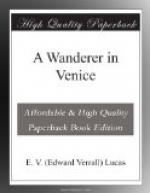The Rio dei Meloni, where is the Palazzo Albrizzi to which Byron used to resort as a lion, runs by the Papadopoli. At the other corner is the Businello, a nice solid building with two rows of round window-arches. Then the tall decayed Rampinelli and, followed by a calle, the Ramo Barzizza, and next the Mengaldo, with a very choice doorway and arches, now a statuary store; then the yellow Avogadro, now an antiquity dealer’s and tenements, with a fondamenta; then a new building, and we reach the fine red palace adjoining the Casa Petrarca, with its ramping garden.
These two palaces, which have a sottoportico beneath them leading to S. Silvestro, stand on the site of the palace of the Patriarchs of Grado, who had supreme ecclesiastical power here until the fifteenth century, when the Patriarchate of Venice was founded with a residence near S. Pietro in Castello.
From this point a fondamenta runs all the way to the Rialto bridge. The buildings are not of any particular interest, until we come to the last one, with the two arches under it and the fine relief of a lion on the facade: once the head-quarters of the tithe collectors.
People have come mostly to speak of the Rialto as though it was the bridge only. But it is the district, of which the bridge is the centre. No longer do wealthy shipowners and merchants foregather hereabouts; for none exist. Venice has ceased to fetch and carry for the world, and all her energies are now confined within her own borders. Enough to live and be as happy as may be!
[Illustration: DOORWAY OF S. MARIA DELLA SALUTE]
In beauty the Rialto falls far short of most of the bridges of Venice. Its hard angle superimposed on the great arch is unpleasing to the eye accustomed in this city to easy fluid curves. Seen from immediately below, the arch is noble; from any greater distance it is lost in the over-structure, angle and curve conflicting.
Ruskin is very enthusiastic over the conceit which placed the Spirito Santo on the keystone of the bridge, the flight, as he thinks, producing an effect of lightness. He is pleased too with the two angels, and especially that one on the right, whose foot is placed with horizontal firmness. On each side of the bridge is a shrine.
Before this stone bridge was built in 1588 by Antonio da Ponte it had wooden predecessors. Carpaccio’s Santa Croce picture in the Accademia shows us what the immediate forerunner of the present bridge was like. It had a drawbridge in the middle to prevent pursuit that way during brawls.
The first palace beyond the bridge, now a decaying congeries of offices, has very rich decorative stone work, foliation and festoons. It was once the head-quarters of the Camerlenghi, the procurators-fiscal of Venice. Then come the long fruit and vegetable markets, and then the new fish market, one of the most successful of new Venetian buildings, with its springing arches below and its loggia above and its iron lamp at the right corner and bronze fisherman at the left.




